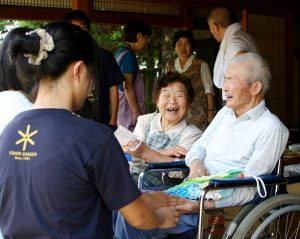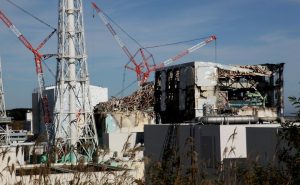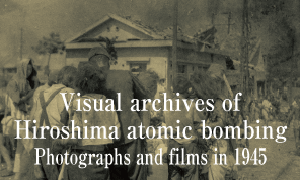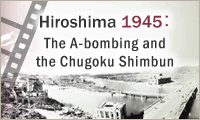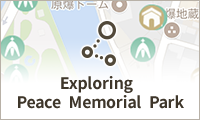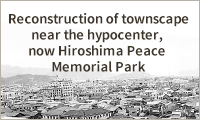Documenting Hiroshima 80 years after A-bombing: March 11, 2011, Fukushima Daiichi nuclear power plant accident
May 27, 2025
Assistance offered to A-bomb survivor also affected by accident
by Maho Yamamoto, Staff Writer
On March 11, 2011, Saichi Ouchi, an 81-year-old A-bomb survivor, was living in a special nursing home for the elderly in the village of Iitate in Fukushima Prefecture. Three years earlier, he had suffered a debilitating stroke, forcing him to relocate from his home to the facility. However, he continued to hold out hope of returning home, even if only temporarily.
Mr. Ouchi was from the Yamakiya district in the town of Kawamata, located to the west of Iitate. During World War II, he had studied at the Kamo Naval Medical School in the village of Kamino (in present-day Higashihiroshima City), Hiroshima Prefecture. Two days after the U.S. military dropped the atomic bomb on Hiroshima, he entered the devastated city center carrying medicine and water and was exposed to radiation from the bombing. Centered mainly on Yokogawa Station (in Hiroshima’s present-day Nishi Ward), he carried out such activities as providing encouragement to the injured.
After the war, he returned to his hometown in Fukushima Prefecture and engaged in farming and silkworm cultivation as well as raised four children. His oldest son, Hidekatsu, 76, who is by definition a second-generation A-bomb survivor, said, “My father was especially concerned about the health of his children, having us undergo health examinations annually until we reached adulthood.”
After his father was admitted to the nursing home, Hidekatsu and his mother, with whom he lived at his parents’ home, regularly visited him. However, radiation’s effects would unexpectedly rob the family of any normality in their daily life.
Designated as evacuation zone
At 2:46 p.m. on March 11, 2011, a massive, 9.0-magnitude earthquake struck off the coast of Sanriku. The Great East Japan Earthquake would register a maximum seismic intensity of lower six on the Japanese scale in the village of Iitate and generate a tsunami that struck the coastal area. The Fukushima No. 1 (Daiichi) Nuclear Power Plant, operated by the Tokyo Electric Power Company, lost power. Losing their cooling functions, three nuclear reactors suffered core meltdowns and hydrogen explosions, resulting in the release of radioactive materials.
The nursing home where Mr. Ouchi stayed in Iitate village was located around 40 kilometers northwest of the power plant. The area would be designated as a “planned evacuation zone” due to its high concentrations of radioactive materials, but Mr. Ouchi chose to remain there out of concern for the potential effects on his health if he were to evacuate.
Because the Yamakiya district in Kawamata was also designated as a planned evacuation zone, Hidekatsu and his mother left their home. Gripped by uncertainty, they thought, “Would we ever be able to return home if we evacuated” and “What can we believe concerning the health effects from radiation.”
Following the accident, the Hiroshima International Council for Health Care of the Radiation-exposed (HICARE), an organization with a secretariat in Hiroshima Prefecture, dispatched a specialist team of X-ray technicians at the request of Fukushima Prefecture to assist with ascertainment of the circumstances of radiation exposure of residents and other work. Some citizens in Hiroshima Prefecture also took action to support those affected. In July 2011, four months after the disaster, five students from Eishin High School in Fukuyama City visited Fukushima Prefecture.
“Going against wish of survivors”
Arisa Masuda, 30, a resident of Fukuyama City who was a second-year high school student at the time, said, “I felt the wish of the A-bomb survivors, which was that ‘No one should ever again suffer as we did,’ were being trampled upon.” Ms. Masuda, who regularly interviewed A-bomb survivors and collected signatures for the abolition of nuclear weapons, hoped to hear directly from Mr. Ouchi, who had been affected by the nuclear power plant accident 66 years after the atomic bombing.
Hidekatsu helped to take his father from the evacuation zone in the town of Kawamata to allow the students to meet with him. In the interview, the students learned about his experiences in the atomic bombing and the reality at that time of Fukushima, with its uncertain future. They presented what they had learned at their school culture festivals and community presentations locally. They continued their communication with Mr. Ouchi by visiting him and others again in 2012 and in 2013.
Never returning to the home where he had lived for many years, Mr. Ouchi died in 2014 at the age of 84. Hidekatsu attended the Peace Memorial Ceremony in Hiroshima in 2016 as a representative of the bereaved families of A-bomb survivors living in Fukushima Prefecture. That same year, he returned to his family home and worked to rebuild his life through farming and other endeavors. “The damage caused by radiation is long-lasting and painful,” said Hidekatsu, who expressed his fervent belief that, “The history of Hiroshima and Fukushima must never be repeated.”
According to a compilation put together by Fukushima Prefectural government and the Fukushima Prefectural Confederation of A-bomb Sufferers Organizations, as of the end of March 2011, there were 92 holders of the Atomic Bomb Survivor’s Certificate in Fukushima Prefecture, eight of whom had lived within a 30-kilometer radius of the Daiichi nuclear power plant. Even now, 14 years after the accident, approximately 25,000 residents of the prefecture continue to live at evacuation sites both inside and outside the prefecture.
(Originally published on May 27, 2025)

